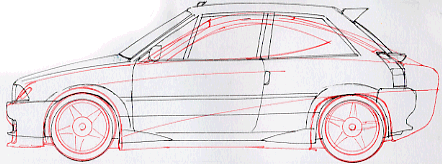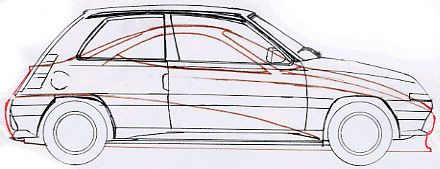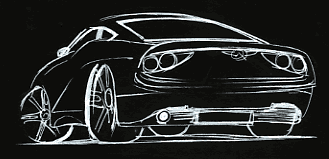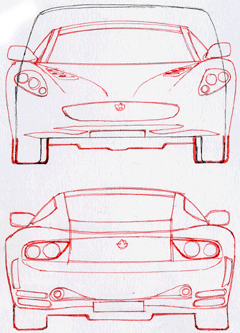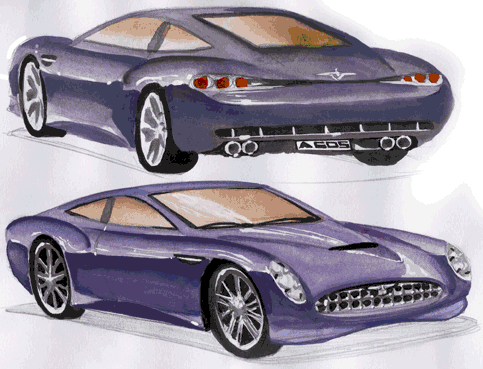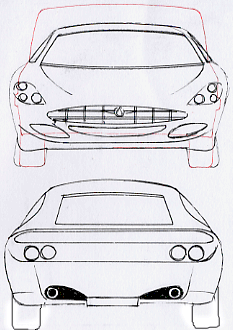
Louis Delage was born in Paris in 1874. Graduated from the engineering school of arts and crafts, he began his career working at Peugeot before creating his own brand in 1905. In Levallois Perret, his factory subcontracted the construction of models from other brands, but he develops a small car, a kind of cyclecar equipped with a De Dion single-cylinder, entered in the race in 1906 and which will win the cup of carts in 1908, equipped with a new Causan 4-cylinder. The brand's characteristic reverse blazoned radiators date from this period. Delage could have, like so many other artisanal firms producing cyclecars, disappeared in the 1920s, but the range is reinforced with general public passenger vehicles. Small 9hp single cylinders, then Ballot 4-cylinders of 1.4 liters, 6-cylinders of 4.5 liters. These touring models represent a volume of 300 cars per year, which quickly forces Delage to settle in large premises in Courbevoie.
In 1913, the first in-house 6-cylinders were built, along with a racing version, the Y type, which won the French GP in 1913, and the Indianapolis 500 in 1914. A new model more modern which should make it possible to win the European GP is equipped with a V6 of 4.5L, but the domination of Mercedes deprives Delage of victory. When the war was over, the production rate, which reached 1,800 cars per year, was quickly exceeded. The success of Delage, winning contracts with the army to provide fast and reliable liaison vehicles is carried over to the beautiful COs of 1918. This 4.5L 6 cylinder side valve develops 20hp and easily reaches 100 km / h. Four years later, a new series promised to success, the CO2, was released, this time with overhead valves.
In 1924, the competition Delages were present in all the hill climbs, which they often won. The engineer Planchon, who succeeded Augustin Legros designed the brand's first V12s, for GP cars in the 2-liter category which won the European GP in 1924, and the following year the Spanish GP and the Grand Prix. price of the automobile club of France. The engineer Lory will put the excellent V8s on the bridge which will allow the racing Delages to win the European GP, the Spanish GP and the British GP in 1926 and to put the cover back in 1927 by winning in addition to these prestigious races the GP of France once again. At the same time, and reflecting on the reputation of the brand, these numerous victories made it possible to sell in large numbers the Delage GL "Grand Luxe" equipped with 6-cylinder of 6 liters. These formidable liners have as rivals only the Hispano-Suiza, the Mercedes, the Packard ... Alongside these monsters, smaller nervous 4-cylinders are presented with a 2-liter 4-cylinder, the DI of 1923 with tumbled engine and side valves followed by DI, DIS and DISS, the latter resulting in excellent sports coupes and roadsters.
New 6-cylinder 3 liters made their entry in 1926: The DM. The DMS are the sporting variants. Then there are the less offensive and less expensive DRs, in 1927. but the real novelty will be visible at the 1929 Paris Motor Show: This is the 4-liter D8 with rocker arms. The engine block derives from that of the racing car entered in 1926-27. These D8s like their D8S sports derivatives are the delight of French coachbuilders, who will sign pure masterpieces awarded for their baroque elegance yesterday and today. However, these models are astronomically expensive and almost sold at a loss. The image of the brand benefits less from the aura of past laurels, and apart from a few speed records (175 km / h for a D8S in 1931), the financial situation is becoming worrying.
The new D6 3-liter 6-cylinder and less powerful DS models did not meet with the expected success. In order to reduce manufacturing costs and widen the range downwards, D8-15 and D6-11 are cheaper than ever but production is weakening. If in 1934 the D8-105 and D6-65 were more modern, the financial situation was such that the main dealer Delage bought the brand and then sold its shares to Delahaye the following year. The latter renews the range by presenting Delage chassis and Delahaye mechanics. The D8-100 and D6-75 thus leave the factory in reduced series. However the engines are still deeply the work of Delage, and Delage will be equipped until 1953, date on which the firm must close its doors, involved in the fall of Delahaye and lack of being modernized in time.
 Models
Models
- Delage GL 1923
- Delage DISS roadster
- Delage DMS Torpédo
- Delage D8S
- Delage D6-75 coach sport
- D8-120 Aérosport
Delage D8-120 Aérosport (1938)

The Letourneur & Marchand D8-120 had a highly aerodynamic style, the modernism of the side windows without the center pillar being confusing.
Type: 2 + 2-seater coupe.
Front engine - rear transmission.
8 cylinders in V, 16 valves 4.7 Liters, 1 ACT, 1 compressor, 130/160 hp DIN @ 4500RPM.
0-100 Km/h: 10 sec.; 1000 D.A .:; Max speed: 140 Km/h.
1830 Kgs.
Length: mm; Width: mm; Height: mm; Wheelbase: 3350 mm
Probably the sportiest and least flamboyant Delage of all the last produced, those of the Delahaye era, the D8-120 on the chassis of the latter brand will be the swansong of the firm. These ultimate machines then have nothing to envy Mercedes or Bentleys in terms of luxury and sporting services, but it is clear that after the war, they will represent dinosaurs. This avant-garde design jewel, strongly favored by the collector's car market, always very well seen in the major international elegance competitions, has a typically French charm and allure, which immediately places it at the pinnacle of the world. car of exception, just like the Bugatti 57.
A Delage/Delayahe for the 2020s: GT Aerosport
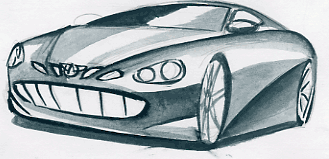 Thinking about what a sports car is today deserves to be approached from all angles. The ambition here is to define the ideal sports car and to distinguish between the model that would be mass-produced and the "most beautiful car in the world", a sort of holy grail of automobile design, subjective in essence, and which would be presented to the vote of Internet users on a site specially dedicated to the horizon 2025. It would then take shape as a concept car and with a little luck and will be presented at the Paris Motor Show in 2025.
Thinking about what a sports car is today deserves to be approached from all angles. The ambition here is to define the ideal sports car and to distinguish between the model that would be mass-produced and the "most beautiful car in the world", a sort of holy grail of automobile design, subjective in essence, and which would be presented to the vote of Internet users on a site specially dedicated to the horizon 2025. It would then take shape as a concept car and with a little luck and will be presented at the Paris Motor Show in 2025.
A GT today:
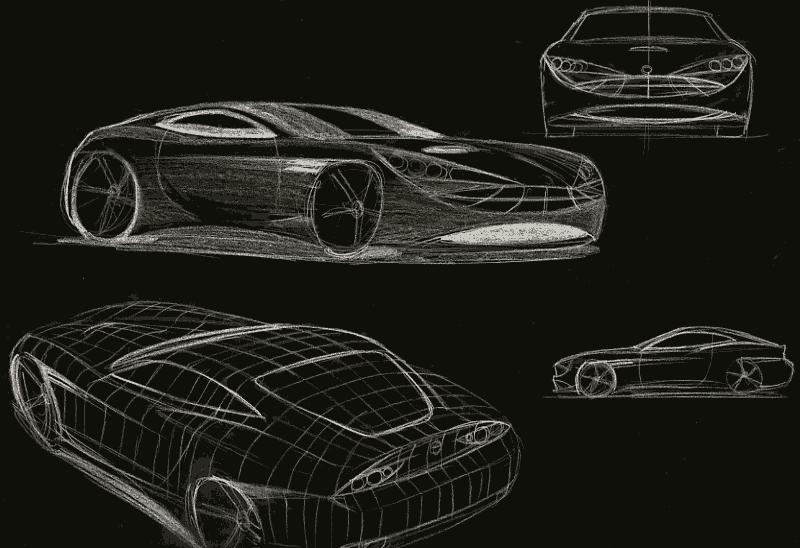
When we look at the question, we are mainly faced with two possibilities (see also "advanced techniques" on Gentleman-driver.com"). In essence, a sports car is capable of the best performance. Much better on all the plans than a standard production car. It is a choice to move away from functionality to enter the realm of driving pleasure. Either we design this car with great emphasis on comfort, and in this case we must consider the weight as being such that the expected performance requires more power than a standard model, or we aim for lightness, and in this case we must ignore comfort, but we can be satisfied with a modest engine. In the first case, it is a car in the "GT" spirit, aimed more at an elite, in the second, it can be a more "sports" car ", aimed at a wider audience.
The previous studies on these vanished prestigious French brands obviously refer to the "GT" spirit. It is therefore not necessary to come back to it. LionDesign is obviously more the construction of an affordable sports car, its selling price, given the techniques used, should not be beyond 40,000 €. The ultimate goal would be to produce a model around €20,000, which is as much as a well-equipped city car, which seems reasonable. I do not even consider the possibility of offering it as a Kit, the standards of French mines have long condemned this solution, not to mention European standards. The solutions to achieve this led me to define the composite portrait of this sports car, the "Lion 2000 GT". There was another project aimed at designing a model reconciling passion and reason, Prometheus, which was to have its gearbox adjusted very short, so as to cap at 150 km/h (20 above the legal limit) but to go from 0 to 100 Km/h in 6.2 or 6.3 seconds thanks to a featherweight due to the materials used, very small measurements and a small engine. But before that, I had considered another project, unique in its kind, aiming for a kind of complete rebodying starting from an existing model, aiming to offer a sports model at less than 15,000 €...
The basic idea is to consider designing a new car from an existing model: In fact, it involves starting from an entire existing base (chassis, mechanics, running gear) and adding a new bodywork, after fittings, in fiberglass. On the one hand to lighten the structure from 150 to 200 Kgs. as is done for the models prepared for the competition, and on the other hand to give them the desired line, a coupe line which would certainly lose in habitability but would gain in style. It would then be a question of equipping it with large diameter rims, wide low-rise tires, and completing these arrangements with an engine upgrade, in particular by reviewing the electronic management, and by adding a turbo. By playing on the three tables, weight, performance and aerodynamic style, we are able to transform any outdated city car into a pretty sports coupe. A fairy tale? A little. but we want to believe it. Imagine... Someone wanting to buy a sports coupe at a lower cost brings back his old Renault Clio from 1992, not really listed on the Argus. reselling it would not have brought him much. Here, we would propose to take it back for transformation.
First stage: Choice of finishes (bucket seats in Recaro leather, for example, wood inserts, while retaining the original switchboards and dashboard, Hi-Fi system, etc.) 2: General and in-depth review to determine, as in any garage, the parts to be changed, those to be kept. Estimate approved by the customer, then technical upgrade. Then, engine adjustment, addition of an electronic control unit, modified gearbox, addition of a turbo, engine adjustments, suspension adjustments, possible installation of new ventilated brakes, installation of wide low-rise tires and large-diameter rims, lowered body (depending on the level of comfort desired by the customer).
Fourth phase, the dismantling having been carried out during the second phase of all the mechanics for overhaul but also of the electrical wiring, headlights and other seats, carpets which can interfere with this phase, we proceed to the desoldering of all the superfluous steel sheet metal (that which does not serve the solidity of the structure). All that remains, above all on the top and the sides, is a steel skeleton which will be modified to receive the upper part of the fiberglass body. The latter will be glued to the lower part, resting nested on the frame. The widening of the crate should be 10-18 cm. The height under roof reduced to 1250 or 1300 mm, thanks to seats designed to have a lower driving position, and also placed lower on the chassis.
This kind of experimentation is not new: We already practiced it with the famous Nova, in the 70s, on the basis of the VW Beetle, the latter has also been used for many other Kits, and it s was a radical transformation. This Carlife2 solution would make it possible to give a second life to many second-hand cars, and on the other hand, to provide those who want it with a bit of the car of their dreams at a lower cost. Based on this principle, I imagined transforming the entire French generalist range.
Coupe project based on a mass-market city car - the principle applies wonderfully to a more recent 206 or Clio. It should be remembered that a Citroën AX same sport (1987-95 hp), weighs only 730 Kgs. empty. After her weight loss treatment she could drop below the 700 Kgs mark. even though it would benefit, for example, from leather and wood finishes and a 120 to 130 hp turbo). Such a power-to-weight ratio obviously makes it a sports car, and not just in appearance. This principle finally applies to sedans, including the largest models, which then lend themselves to 2+2 coupé versions. Their V6s are also a strong argument. Here, for example, is the restyling project based on the Citroën BX. The concept is also interesting because of the possibility of adjusting its air suspension very low. For the record, the BX GTI 16 valves of 1987 gave 160 hp. After lightening, it could go from 1070 Kgs to 980. (the period boxes, giving pride of place to plastics, were still quite light...). With a turbo, we can consider going from 160 to 210 hp. The result: 210 hp for 980 Kgs. empty... Another emblematic model, from the Peugeot range this time, the 205 deserves a transformation worthy of its nervousness and its handling: The Lion 205 GT would benefit in GTI version, from a weight reduced from 880 to 800 Kgs, for a 4-cylinder sixteen valves of 130 hp pushed to 180 with turbo.
The extreme 405 T16 could also serve as the basis for a 2+2 coupe, but the odds are that the MI16 would be more likely to benefit from it, due to its wide distribution. The "special" Lion 405T16, overall an optimized turbo MI16, would see its weight reduced from 1110 to 980 Kgs., for its 200 hp, possibly pushed to 210 thanks to a revised electronic management. The MI16 would probably achieve the same benefits, but in the full version (1240 Kgs.) it would be difficult to get it back above the ton bar, unless it was purged in the "supersport" version, for competition. Finally, the large 605 could also serve as the basis for a very livable 2+2 coupé: The 3-litre V6 version would of course be a magnificent base for transformation.
This V6 develops 200 hp, but reworked and coupled to a biturbo like that of the Venturi 300 Atlantique, we would get 300 or 330 hp. Compared to the weight of the sedan, 1460 Kgs. reduced to 1250, we have a machine with formidable capacities. The Renaults also deserve special treatment: The R5 to begin with, but more recent, the R21, going from 1140 to 980 Kgs. and from 140 to 190 hp: The more recent R19 would also produce a perfectly acceptable 2-seater coupé, especially in the 16-valve version, it would go from 1050 to 900 Kgs. and from 140 to 190 hp. Finally, the large R25, and its unsightly, but wide and low tailgate, could make an excellent 2+2 coupe that is quite plush. The R25 in its 2.5-litre V6 turbo version, formerly Baccara, could hardly go from 205 to over 220 hp, for a weight reduced from 1,410 to 1,250 kg. The V6 2.8 L 140 cv on the other hand could reach a higher power, up to 230 cv, for 1230 Kgs.
It would not be improvised on an existing base, if not mechanical, but would start from a specially dedicated tubular frame, reinforcing an integral fiberglass body (The top part being glued to the bottom part, itself embedded in the frame tubular.). It would be designed around a large series engine, and would be offered within a large generalist distribution network. Switches, headlights, windows, wiring, mechanics, running gear from large series for obvious reasons of economy. The "2000" is a reference to its engine capacity. ideally a 4-cylinder 2 liter 16 valve like that of the 206 RC, developing 180 hp, and capable of receiving the addition of a turbo would allow this range to be split between a sports model (16s atmospheric) and turbo (GT , with luxurious finishes. ) In a first case, 180 hp. under the foot for 850 Kgs., in the second 220 for 900 Kgs. In both cases, the possibility of performing the 0 to 100 in 5.8 seconds for 250 km/h.
The Sport, to remain very accessible, could opt for a tubular steel frame, the GT for an aluminum frame, allowing to glean about twenty Kilos on the total and allow to install an ABS, ESP, traction control, etc. On a general level, the use of the windows of a Peugeot, re-cut to the desired format, with headlights in the shape of feline eyes, which are very suitable for a "Lion" for obvious reasons, and the name itself, belonging to the Peugeot family, inaugurate an essential collaboration with the Sochaux brand, Lion becoming for example its sports showcase, with "AMG" style perspectives why not... The Lion 2000 GT would also be designed as a Targa coupé, this which is still better than a coupé-cabriolet, less rigid: The central bar reinforces the structure, leaves only two panels to be dismantled and stored in the boot, and with all the windows down, the upper rear part of this coupé, window down , would serve as a large hoop e security perfectly integrated into the bodywork.
There remains the question of the positioning of the engine. Ideally it should be placed in the rear center position, ensuring the best balance. But this would require high study costs, and ultimately costs that are not very compatible with the initial objective. The simplest solution would therefore be to place this engine in the front position, front-wheel drive, which would have disadvantages on the road holding at high speed, in particular understeer, unless aiming for the production of a model less efficient (0-100 Km/h in 7 seconds, 220 Km/h.) There is also in the boxes of LionDesign a project for a berlinetta with a central rear engine, the Valkyrie. It is the latter that will be developed around the V6 biturbo Peugeot (330 hp) as the most beautiful car in the world, acclaimed by Internet users.
